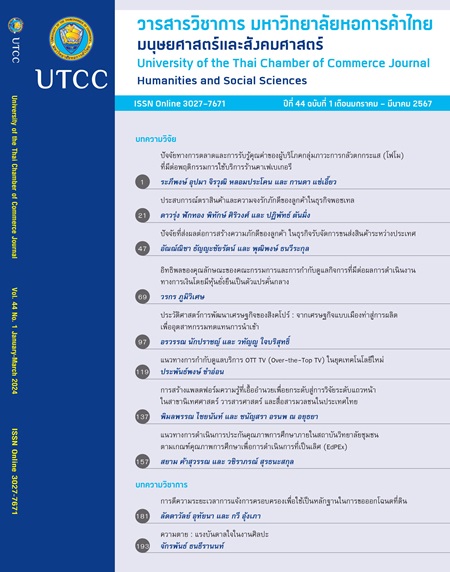Building an Enabling Knowledge Platform for Frontier Research in Communication, Journalism and Mass Media Studies in Thailand
Main Article Content
Abstract
This study aims to develop an open, flexible, and user-friendly digital platform. This platform will serve as a useful tool for collecting, searching, distributing, and linking research and academic knowledge in the fields of communication studies, journalism, and mass communication in Thailand. Furthermore, it seeks to encourage community participation and collaborative learning through the development and testing of this prototype platform.
The development of the prototype involves two stages. The first stage focuses on exploring current issues and synthesizing stakeholder demands. This is accomplished by gathering information from a sample of university lecturers and graduate students who are active contributors to the field of communication studies. The methods employed include in-depth interviews with 11 participants and a survey questionnaire administered to 106 individuals. The findings reveal two key insights: while there is a strong demand for an information and knowledge-based platform, there are significant challenges in creating, accessing, and disseminating communication knowledge due to fragmented university efforts. Each institution has distinct research goals and identities, and their strategic objectives do not encompass developing a dedicated system for communication studies. Additionally, disciplinary scholarships often influence how researchers utilize databases. The results revealed a high demand for an information and knowledge-based platform. The most sought-after feature was a database for academic journals from national archives, with an average score of 4.49. This was closely followed by a demand for a database for academic journals from international archives, scoring an average of 4.46. Lastly, a site providing accurate citation information for such journals based on academic referencing systems was also in demand, with an average score of 4.45. In the second stage, the prototype platform was designed to meet the needs identified in the first stage and underwent pilot testing by the target user group. The results indicated that users viewed the platform, which functions as a database, as a fundamental infrastructure for advancing knowledge in the field of communication studies. They expressed satisfaction with the platform’s visual design and user experience, particularly appreciating its capabilities for searching, information exchange, and facilitating scholarly discussions.
Article Details

This work is licensed under a Creative Commons Attribution-NonCommercial-NoDerivatives 4.0 International License.
ลิขสิทธิ์ของบทความ
ผลงานที่ได้รับการตีพิมพ์ถือเป็นลิขสิทธิ์ของมหาวิทยาลัยหอการค้าไทย ห้ามมิให้นำเนื้อหา ทัศนะ หรือข้อคิดเห็นใด ๆ ของผลงานไปทำซ้ำ ดัดแปลง หรือเผยแพร่ ไม่ว่าทั้งหมดหรือบางส่วนโดยไม่ได้รับอนุญาตเป็นลายลักษณ์อักษรจากมหาวิทยาลัยหอการค้าไทยก่อน
References
พิรงรอง รามสูต, เสริมศิริ นิลดำ และ โสภาค พาณิชพาพิบูล. (2564). การสำรวจสถานการณ์ปัญหาและการพัฒนาระบบความรู้นิเทศศาสตร์ วารสารศาสตร์ และการสื่อสารมวลชนในประเทศไทย ใน สถาบันวิจัยสังคม จุฬาลงกรณ์มหาวิทยาลัย, โครงการจัดทำสมุดปกขาวข้อเสนอแนะเชิงนโยบายเพื่อการยกระดับระบบบริหารจัดการความรู้และการปรับปรุงโครงสร้างความรู้ทางสังคมศาสตร์ของประเทศไทย (น. 240 – 322). สืบค้นจากhttp://www.cusri.chula.ac.th/wp-content/uploads/2022/12/รายงานฉบับสมบูรณ์ข้อเสนอแนะเชิงนโยบายเพื่อการยกระดับระบบบริหารจัดการความรู้.pdf
ศูนย์ดัชนีการอ้างอิงวารสารไทย (Thai-Journal Citation Index). (ม.ป.ป.). เกี่ยวกับ TCI. สืบค้นเมื่อ 2 กรกฎาคม 2564, จาก https://tci-thailand.org/
Israel, G. D. (1992). Determining Sample Size. Retrieved October 12, 2023, from https://www.psycholosphere.com/Determining%20sample%20size%20by%20Glen%20Israel.pdf
Jakubik, M. (2008). Experiencing collaborative knowledge creation processes. The Learning Organization, 15(1), 5-25. doi: 10.1108/09696470810842475
Nonaka, I. & Takeuchi, H. (1995). The knowledge creating company: How Japanese companies create the dynamics of innovation. Oxford: Oxford University Press.
Open Archive for Media, Film, and Communication Studies. (n.d.). MediArXiv FAQs. Retrieved July 2, 2021, from https://mediarxiv.com/faqs/
Open Researcher and Contributor ID. (n.d.). About ORCID. Retrieved July 2, 2021, from https://info.orcid.org/what-is-orcid/
Social Science Research Network. (n.d.). What is SSRN?. Retrieved July 2, 2021, from https://service.elsevier.com/app/answers/detail/a_id/34348/supporthub/ssrn/p/16539/
Vera, D. & Crossan, M. (2003). Organizational learning and knowledge management: Toward an integrative framework. In M. Easterby-Smith, & M. A. Lyles (Eds), The Blackwell handbook of organizational learning and knowledge management (pp. 122-142). West Sussex, UK: Blackwell.


